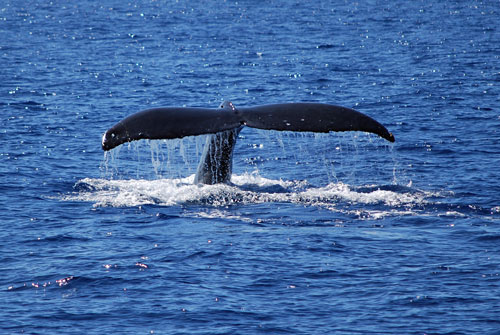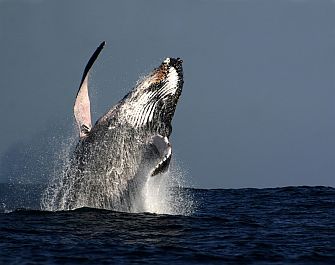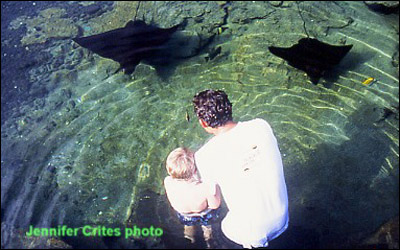Hawaii Ocean Life
Humpback Whales in Hawaii
Have A Whale Of A Time In Hawaii Island – The Big Island

Hawaii’s warm, inviting waters is home to a variety of whales and dolphins. One whale species which is among the most popular for whale watching is the Humpback whale. The Humpback whale migrates to Hawaii in winter months from December to March to calve and to mate. Other whale species make Hawaii their homes throughout the year, but the winter season is when to be in Hawaii to experience the fascinating Humpback whales.
The Humpback whale is a huge mammal which belongs to the Baleen whale species. How large do they become? An adult humpback ranges in size from 40 – 50 feet long and weights in at approximately 80,000 pounds. They are relatively easy to spot along the coastline here, if you know what signs to look for. Usually, the first sign of a Humpback is their water spout when they surface to breath. And, these whales are well known for unexpectedly propelling itself out of the water (breaching), twisting itself around in mid air before crashing back in the water with a thunderous splash. Sometimes the humpbank will roll around on the water’s surface, slap its unusually long front fins onto the water, and slap it’s tale upon the water repeatedly.

While the Humpback whale spends its winter in Hawaii it does not feed here but rather lives off of its own fat reserves from feeding throughout the summer months. In the summers, it eats small sea creatures such as krill and schooling fish like herring – stunning them by hitting the water with its flippers or flukes.
The humpback whale is well known for its “song” generated by forcing air through their nasal cavities. The song is a pattern of low notes that vary in amplitude and frequency in consistent patterns over a period of hours or even days. You may be curious about what the “song” activity means, but it seems that scientists are still unsure why the humpback “sings”. As it is only the male that sings, it was first assumed that it was to attract a mate. But, it’s also believed that the whale’s song serves other purposes. Years of research revealed that one of the most intriguing things is that a whale’s unique song slowly evolves over a period of years —never returning to the same sequence of notes even after decades.
If you’ve never heard “whale song”, you can listen and watch “LIVE” directly from a Hawaii Island – Big Island – whale research station which positions a special buoy anchored in the Kohala Coast during the winter season [December to March] when the humpbacks are here. But, outside those months, you can listen to the research station’s archive of Humpback song library to hear their most recent recordings: Jupitor Research Foundation
Humpback whales are generally curious about objects in their environment and they have been known to approach and circle boats. We were entertained by this scene of a couple relaxing in their boat on a typical afternoon fishing offshore in front of the Kailua-Kona airport, on Hawaii’s Big Island:



During your visit, if you should do any boating or kayaking, be particularly mindful of the mother humpbacks with their calves. A mother whale will be extremely protective of her calf and she will place herself in between a boat and the calf before leading it away from the vessel. If you’re too close, this action could upset and upturn your boat. Do not attempt to paddle out to approach a mother with a calf.
Through the mid 1900’s, the Humpback whale was near extinction due to commercial whaling. Currently, the North Pacific Humpbacks have been protected since 1966 and appear to be recovering slowly. It is now estimated that there are more than 20,000 Humpbacks in the North Pacific region with approximately 10,000 visiting the Hawaiian Islands in any one winter. The future of the Humpback whale is still uncertain, however, though researchers are optimistic that the population could recover if control of commercial whaling were the sole consern. However, according to Dan McSweeny, Wild Whale Research Foundation in Hawaii, impacts on the whale’s habitat and food supply are ongoing problems.
If you visit Hawaii outside the winter season, other whale species that are year-round residents of Hawaii’s waters are the Sperm whale, False Killer whale, Pilot whale and, of course, dolphins.
Big Island whale watch – Whale watch on the Kohala Coast, Big IslandKohala Divers located in Kawaihae Habor & Marina on the Big Island, about 10-min drive from our Aloha Vacation Cottages, offer a wide variety for ocean activities like whale watch, snorkel & scuba diving, & sunset cruises on the Kohala Coast. Sail Hawaii the Big Island for adventure with Maile Charters from Kawaihae Marina.
StingRays

At the Four Seasons Hualalai Resort on the Big Island, visitors to the resort can view and feed these very shy spotted eagle rays at the ray lagoon…this spectacular event takes place daily in the afternoons
Stingray Safari by Jennifer Crites
“…and that brings me to the subject of the month – stingrays. Well, actually, all 9 types of rays in Hawaiian waters, including manta rays, devil rays and electric rays. Even though most people lump them all together as “stingrays,” each one is unique.
Take electric rays, for example. That’s just a nickname. Their actual name is torpedo ray. Don’t ask me why; they don’t look anything like a torpedo, and they’re not stingrays either. But I’ll tell you one thing – don’t ever make ’em mad. They have organs in their bodies that can send out an electric shock if you touch ’em. Talk about getting zapped! Mostly they use it to protect themselves or stun their food. Kind of gives them an unfair advantage if you ask me. When you go for a swim in the ocean, don’t worry about bumping into one, though – they live pretty deep: 300 to 1,500 feet down.
Ok, how about manta rays. They’re not stingrays either, but you’re gonna love these guys. They’re one critter down here that isn’t dangerous. First of all, they have no teeth to speak of. You know what they eat? Plankton. Can you believe it? I mean, manta rays are huge. Even when they’re born, their wingspan is about 3 feet from tip to tip. ‘Course, right before they make their entry into the world they don’t look that big because their wings are folded around their bodies. Makes ’em look like big bats (without the teeth, of course). Anyway, just digesting tiny plankton, they can grow to a whopping 22-foot wingspan.
There’s a story in Jennifer’s book about a human on the Big Island who went out on his boat to do a little fishing. He dropped his anchor at Kealakekua Bay and was about to go for a dive to check out the big manta he’d just seen, when the boat started moving. I mean, it took off fast forward, then sideways, tilting over at a scary angle. He was hanging on for dear life but glad he hadn’t gotten in the water because then he’d be watching his boat take off for China. Anyway, after being thrown around awhile, he was finally able to cut the anchor line. But not before he saw a big blip on the fish finder and figured out that the manta had somehow gotten caught up in the anchor and was dragging the boat around. Talk about your incredible hulk!
Personally, I think the anchor got caught in the manta’s mouth like a hook. I mean, how else could it have happened? They do have pretty big mouths – all the better to inhale the tons of plankton they need to survive. Speaking of that, have you ever seen them feeding. They’re almost as graceful as a shark – doing loop-de-loops over and over with their mouths agape (I love those fancy words), scooping up the plankton.
If you’re ever over on the Big Island, you can probably see them from the Mauna Kea Beach Hotel’s oceanside terrace. Those hotel people are pretty tricky. They shine lights on the ocean at night. The lights lure the plankton, and following the plankton are, guess what? Manta rays. Some of the dive shops over there will even take you out at night to dive with the mantas. Don’t worry about getting in the water with them – they’re very gentle, and so absorbed in feeding, they don’t pay much attention to humans.
Maybe you’ll even see Lefty. Mantas have two big flaps, called cephalic horns, on either side of their mouths. These cephalic horns help guide the plankton into the mouth. Lefty has one cephalic horn (the left one) that droops. You can’t miss her.
Mantas aren’t the only rays you can see up close on the Big Island. The Four Seasons Hualalai Resort has a ray lagoon inhabited by several spotted eagle rays. You can go swimming in the lagoon (call them first for rules and regs), and at certain times of day you can hand feed the rays (with the help of a resort employee, of course).”

Sharks and Rays of Hawai’i – by Gerald L. Crow and Jennifer Crites – is easy to read and packed with everything you’ve ever wanted to know about these amazing animals: In-depth fact sheets covering 40 species of sharks and 9 species of rays; chapters on anatomy and senses, feeding habits and reproduction, a shark’s-eye view of how volcanic islands are formed, the importance of sharks in Hawaiian culture, first-person stories of encounters with sharks and rays, and hundreds of never-before-published photographs. Makes a great gift for divers, students and anyone from 8 to 80 who is fascinated by the ocean and its inhabitants.
